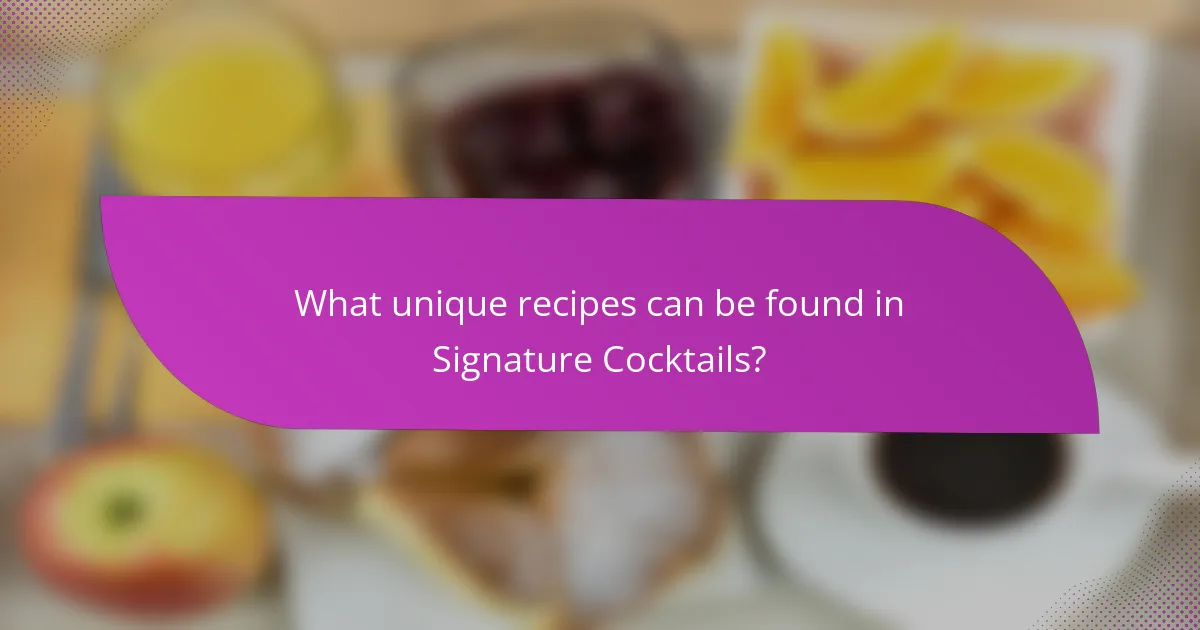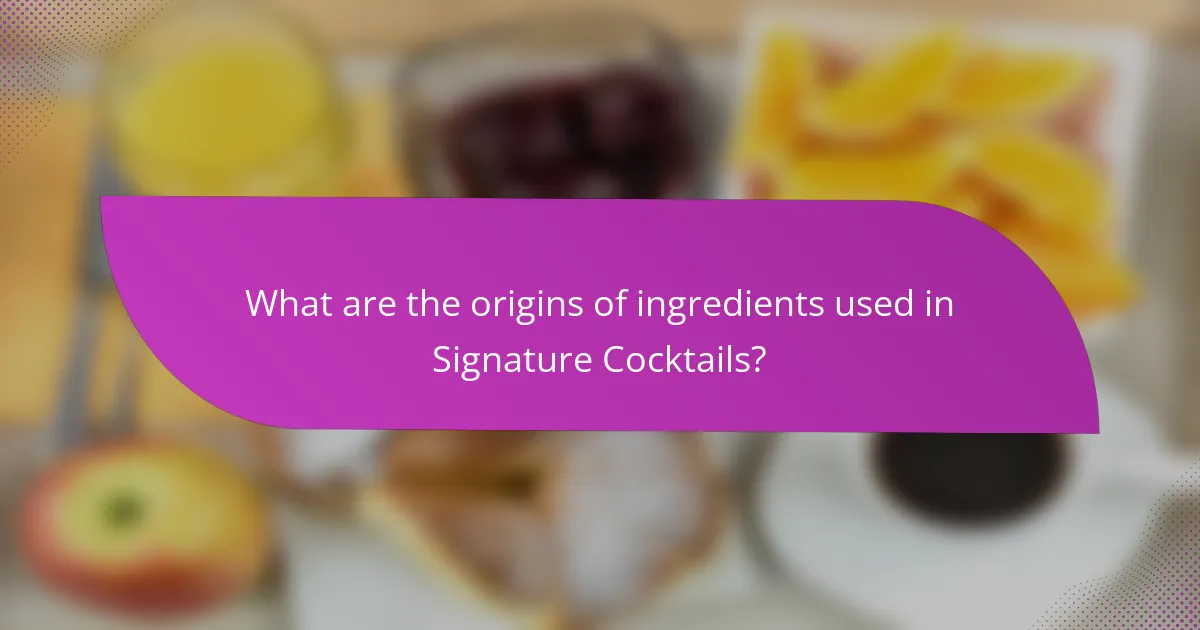Signature cocktails are distinctive drink recipes designed to embody the essence of a brand, event, or individual. This article explores the unique recipes that characterize signature cocktails, highlighting innovative flavor combinations such as the Lavender Martini and Spicy Margarita. It examines the origins of ingredients used in these cocktails, detailing how regional and seasonal influences shape their profiles. Additionally, the article discusses the importance of presentation styles and artisanal ingredients in enhancing the overall experience, particularly in craft cocktail bars and upscale dining establishments. Through this exploration, readers will gain insight into the cultural significance and creative aspects of signature cocktails.

What are Signature Cocktails?
Signature cocktails are unique drink recipes specifically crafted to represent a brand, event, or individual. They often incorporate distinctive ingredients and flavors that reflect the identity of the creator. Signature cocktails can enhance the overall experience of a gathering. They are commonly featured at weddings, parties, and bars to create a memorable impression. Many establishments develop their own signature cocktails to differentiate themselves in a competitive market. The use of artisanal ingredients and creative presentation styles further elevates these drinks. This trend has grown in popularity, particularly in craft cocktail bars and upscale restaurants.
How are Signature Cocktails defined and categorized?
Signature cocktails are defined as unique drink recipes created specifically for an event, establishment, or individual. They often reflect the personality or theme associated with the occasion. Categorization of signature cocktails can occur based on various factors. These include flavor profiles, ingredients, and presentation styles. Common categories are fruity, herbal, spicy, or creamy. Additionally, cocktails may be categorized by their base spirits, such as vodka, gin, or rum. Signature cocktails may also be classified by their complexity, ranging from simple mixes to elaborate concoctions. Each category showcases distinct characteristics that appeal to different preferences. This structured approach helps bartenders and mixologists create memorable experiences for patrons.
What distinguishes a Signature Cocktail from other cocktails?
A Signature Cocktail is distinguished by its unique recipe and identity, often tailored to a specific event or establishment. Unlike standard cocktails, a Signature Cocktail reflects the personality of its creator or venue. It typically features distinctive ingredients or preparation methods that set it apart. For example, a Signature Cocktail may incorporate locally sourced ingredients or a special garnish. This uniqueness enhances the guest experience and creates memorable associations. Signature Cocktails often become a hallmark of a bar or restaurant, attracting patrons seeking something special.
What are the common characteristics of Signature Cocktails?
Signature cocktails are distinct drinks crafted to reflect a specific theme or personality. They often feature unique combinations of ingredients that are not commonly found in standard cocktails. Signature cocktails typically have a creative presentation, often garnished with fresh herbs or fruits. They are usually associated with a particular venue or event, enhancing the overall experience. The recipes for these cocktails often emphasize quality ingredients, showcasing artisanal spirits or locally sourced products. Additionally, signature cocktails may include a personal touch from the mixologist, making each drink a unique creation. These characteristics help define the identity of the cocktail and elevate the drinking experience.
Why are Signature Cocktails popular in social settings?
Signature cocktails are popular in social settings because they create a unique experience for guests. These cocktails often reflect the theme or personality of an event. They encourage social interaction as guests discuss and share their thoughts on the drinks. Signature cocktails can also enhance the overall aesthetic of a gathering, making it more memorable. According to a survey by the National Restaurant Association, 60% of consumers prefer unique beverages at events. This preference drives hosts to offer customized options that stand out. Additionally, signature cocktails can be tailored to taste preferences, accommodating diverse palates. This personalization fosters a sense of inclusion and enjoyment among attendees.
How do Signature Cocktails enhance the drinking experience?
Signature cocktails enhance the drinking experience by offering unique flavors and personalized presentations. These cocktails often incorporate distinctive ingredients that reflect the personality of the creator or the theme of the event. The combination of flavors in signature cocktails can create memorable taste sensations that elevate the overall enjoyment.
Additionally, the visual appeal of a well-crafted signature cocktail can enhance the aesthetic experience. Creative garnishes and stylish glassware contribute to this effect. A study by the Journal of Sensory Studies found that visually appealing drinks can enhance perceived taste and enjoyment.
Overall, signature cocktails provide a tailored drinking experience that engages multiple senses, making them more enjoyable than standard beverages.
What role do Signature Cocktails play in events and celebrations?
Signature cocktails enhance events and celebrations by adding a personalized touch. They reflect the theme or purpose of the occasion. Custom cocktails can create memorable experiences for guests. They serve as conversation starters, fostering social interaction. Signature cocktails often incorporate unique ingredients, showcasing creativity. This can elevate the overall atmosphere and enjoyment of the event. Additionally, they can be visually striking, contributing to the aesthetic appeal. Historical trends show that unique beverages have been integral to celebrations for centuries.
What are the essential components of creating a Signature Cocktail?
The essential components of creating a Signature Cocktail include a base spirit, complementary flavors, and a unique presentation. The base spirit serves as the foundation, typically chosen for its character. Complementary flavors are added through mixers, bitters, or liqueurs that enhance the base spirit. A unique presentation distinguishes the cocktail, often involving garnishes or special glassware. For instance, a well-crafted cocktail balances flavors to create a harmonious taste experience. The use of fresh ingredients can elevate the cocktail’s quality. Additionally, signature cocktails often reflect personal or thematic elements, making them memorable.
What ingredients are typically used in Signature Cocktails?
Signature cocktails typically use a combination of spirits, mixers, and garnishes. Common spirits include vodka, gin, rum, tequila, and whiskey. Mixers often consist of juices, sodas, and tonic water. Fresh herbs, fruits, and flavored syrups are popular garnishes. Each ingredient contributes to the cocktail’s unique flavor profile. Signature cocktails are crafted to reflect the personality of the event or the preferences of the creator. The combination of these ingredients creates a distinctive drink that stands out.
How do the proportions of ingredients affect the final drink?
The proportions of ingredients significantly affect the final drink’s flavor, strength, and appearance. A balanced ratio enhances the drink’s overall taste and ensures no single flavor dominates. For example, a cocktail with too much alcohol may taste harsh, while too much mixer can dilute the flavors.
Adjusting ingredient proportions alters sweetness, bitterness, and acidity levels. A classic example is the whiskey sour, which requires precise ratios of whiskey, lemon juice, and sugar for optimal balance. Studies show that minor adjustments in these proportions can shift the drink from overly sweet to perfectly tart.
Additionally, the visual appeal of a drink is influenced by ingredient ratios. A well-balanced cocktail often showcases vibrant colors and layers. In contrast, improper proportions can lead to an unappealing appearance. Therefore, precise measurements are crucial for achieving the desired sensory experience in signature cocktails.

What unique recipes can be found in Signature Cocktails?
Signature Cocktails feature a variety of unique recipes that highlight innovative flavor combinations. Examples include the Lavender Martini, which uses lavender-infused gin and fresh lemon juice. Another is the Spicy Margarita, incorporating jalapeño-infused tequila and fresh lime juice. The Smoked Old Fashioned offers a twist with smoked bourbon and bitters. Additionally, the Blackberry Basil Smash combines muddled blackberries with fresh basil and gin. These recipes showcase distinctive ingredients and creative preparation methods. Each cocktail is crafted to provide a memorable tasting experience, often reflecting regional influences or seasonal ingredients.
How can one create a unique Signature Cocktail recipe?
To create a unique Signature Cocktail recipe, start by selecting a base spirit that resonates with your taste. Consider flavor profiles that complement the spirit, such as sweet, sour, or bitter. Experiment with fresh ingredients like herbs, fruits, and spices to add depth. Incorporate a unique modifier, such as a flavored syrup or liqueur, to enhance complexity. Balance the cocktail by adjusting the proportions of each ingredient. Presentation is crucial; choose glassware and garnishes that reflect the cocktail’s theme. Document your recipe for consistency in future preparations. Unique cocktails often stem from personal experiences or cultural inspirations, so infusing your story can make the drink special.
What steps are involved in developing a new cocktail recipe?
To develop a new cocktail recipe, follow a structured process. Begin by selecting a theme or concept for your cocktail. This could be seasonal ingredients or a specific flavor profile. Next, choose your base spirit, which serves as the foundation of the drink. Then, consider complementary flavors and ingredients, including mixers, bitters, and garnishes.
Experiment by mixing different proportions of these ingredients. Taste and adjust until achieving a balanced flavor. Document the recipe meticulously, noting each ingredient and its quantity. Finally, present your cocktail creatively, considering glassware and garnishing techniques. This process ensures a unique and enjoyable cocktail experience.
What role does experimentation play in crafting unique cocktails?
Experimentation is crucial in crafting unique cocktails. It allows mixologists to explore new flavor combinations and techniques. Through experimentation, bartenders can identify unexpected pairings that enhance the drink’s profile. This process often leads to the development of signature cocktails that stand out. Historical examples show that many classic cocktails originated from innovative experimentation. For instance, the Margarita evolved from mixing tequila with various citrus flavors. Additionally, modern trends encourage the use of unconventional ingredients, like herbs or spices. This creative approach keeps cocktail culture dynamic and engaging. Ultimately, experimentation fosters originality and personal expression in mixology.
What are some popular Signature Cocktail recipes?
Mojito, Margarita, and Old Fashioned are popular signature cocktail recipes. The Mojito combines white rum, sugar, lime juice, soda water, and mint. It originates from Cuba and is known for its refreshing taste. The Margarita consists of tequila, lime juice, and orange liqueur, often served with a salted rim. This cocktail is associated with Mexican cuisine. The Old Fashioned features bourbon or rye whiskey, sugar, Angostura bitters, and a twist of citrus peel. It is considered one of the oldest cocktails, dating back to the early 19th century.
What ingredients are featured in well-known Signature Cocktails?
Signature cocktails feature a variety of ingredients that define their unique flavors. Common ingredients include spirits like vodka, gin, rum, and whiskey. Fresh fruits such as lime, lemon, and berries are often used for zest. Sweeteners like simple syrup or triple sec enhance the taste. Bitters are frequently added for complexity. Herbs like mint or basil provide freshness. Garnishes such as olives or citrus peels add visual appeal. Each cocktail’s ingredient combination creates a distinct experience. Signature cocktails often reflect the bartender’s creativity and the establishment’s theme.
How do the flavors of these recipes appeal to different palates?
The flavors of these recipes appeal to different palates by offering a diverse range of taste profiles. Each cocktail combines various ingredients, creating unique flavor combinations. For example, some recipes feature citrus elements that attract those who enjoy bright and refreshing tastes. Others incorporate herbal or spicy notes, appealing to individuals who prefer complex flavors. Sweet cocktails cater to those with a preference for dessert-like beverages. Additionally, the balance of sweet, sour, bitter, and umami elements in these recipes can satisfy a wide array of taste preferences. This variety ensures that there is something for everyone, regardless of their individual palate.

What are the origins of ingredients used in Signature Cocktails?
The origins of ingredients used in signature cocktails vary widely. Many spirits originate from specific regions, such as vodka from Russia and gin from England. Fresh fruits and herbs often come from local farms or tropical regions. For example, citrus fruits like limes and lemons are commonly sourced from warmer climates. Sweeteners like sugar and honey have historical roots in ancient civilizations. Bitters, a key cocktail component, originated in Europe for medicinal purposes. Each ingredient’s history reflects cultural practices and trade routes. The blending of these diverse elements creates unique flavor profiles in signature cocktails.
How do the origins of ingredients influence cocktail flavor profiles?
The origins of ingredients significantly influence cocktail flavor profiles. Ingredients sourced from different regions often possess unique taste characteristics. For example, citrus fruits from California may have a sweeter profile than those from Mexico. Similarly, herbs like basil can vary in flavor intensity based on their growing conditions. The terroir, or environmental factors, plays a crucial role in shaping these flavors. Historical cultivation practices also impact the taste of ingredients. Traditional methods may enhance certain flavor notes, while modern techniques could alter them. Additionally, the cultural context surrounding ingredients can influence how they are perceived and used in cocktails. For instance, tropical fruits are often associated with refreshing, vibrant drinks in Caribbean cultures. Thus, the origins of ingredients are essential in determining the overall flavor experience of a cocktail.
What are some common ingredients and their historical backgrounds?
Common ingredients in cocktails include spirits, bitters, and mixers. Vodka, a popular spirit, originated in Eastern Europe, with records dating back to the 8th century. Gin, derived from juniper berries, has roots in the Netherlands and became prominent in England during the 17th century. Rum, made from sugarcane, has a history tied to the Caribbean and was a significant trade commodity in the 18th century. Bitters, essential for flavoring cocktails, were first created in the 19th century, with Angostura bitters being one of the most recognized brands. Vermouth, a fortified wine, emerged in Italy in the 18th century and is crucial for drinks like the Martini. Fresh fruits and herbs, often used as garnishes, have been part of cocktail culture since the early 20th century, enhancing both flavor and presentation. Each ingredient carries a rich history that contributes to the overall experience of signature cocktails.
How does the sourcing of ingredients affect cocktail quality?
Sourcing of ingredients directly impacts cocktail quality. High-quality, fresh ingredients enhance flavor and aroma. For example, using locally sourced fruits ensures peak ripeness and taste. Additionally, premium spirits contribute to a smoother finish. Organic ingredients often lack preservatives, resulting in a cleaner profile. Studies show that cocktails made with fresh herbs and spices have more vibrant flavors. Furthermore, the origin of ingredients can introduce unique characteristics. For instance, regional citrus can alter the acidity and sweetness of a drink. Overall, thoughtful sourcing elevates the overall cocktail experience.
Why is the presentation style important for Signature Cocktails?
The presentation style is crucial for Signature Cocktails because it enhances the overall drinking experience. A visually appealing cocktail can attract attention and stimulate interest. Presentation can convey the theme or concept behind the cocktail, making it more memorable. For instance, unique glassware or garnishes can reflect the cocktail’s flavor profile or origin. Studies show that first impressions significantly influence taste perception. Therefore, an aesthetically pleasing presentation can elevate the perceived quality of the drink. This alignment between visual appeal and taste can lead to increased customer satisfaction and repeat orders.
What are the common presentation styles for Signature Cocktails?
Common presentation styles for signature cocktails include elegant glassware, vibrant garnishes, and creative ice shapes. Elegant glassware enhances the visual appeal and often reflects the cocktail’s theme. Vibrant garnishes, such as fresh herbs or colorful fruits, add a pop of color and flavor. Creative ice shapes, like spheres or cubes, can elevate the drink’s presentation. Layered drinks showcase different colors and textures, creating a striking visual effect. Rimmed glasses with sugar or salt provide an additional aesthetic and flavor element. These styles are often used in upscale bars and restaurants to offer a unique drinking experience.
How does presentation impact the overall experience of the drink?
Presentation significantly impacts the overall experience of a drink. It influences first impressions and sets expectations for flavor and quality. A visually appealing drink can enhance enjoyment and create a memorable experience. Studies show that aesthetics can affect taste perception. For instance, a study published in the Journal of Sensory Studies found that participants rated drinks higher when they were presented attractively. Additionally, unique glassware or garnishes can evoke emotions and enhance social interactions. Overall, presentation plays a crucial role in how a drink is perceived and enjoyed.
What tips can enhance the creation and enjoyment of Signature Cocktails?
Use fresh, high-quality ingredients to enhance signature cocktails. Fresh fruits and premium spirits elevate flavor profiles. Experiment with unique flavor combinations to create distinct tastes. Balance sweetness, acidity, and bitterness for a well-rounded drink. Utilize proper glassware to enhance presentation and drinking experience. Garnishes should complement the cocktail’s flavor and aesthetics. Serve cocktails at the appropriate temperature for optimal enjoyment. Lastly, consider the cocktail’s story or theme to engage guests and enhance the overall experience.
How can one effectively pair Signature Cocktails with food?
To effectively pair Signature Cocktails with food, consider the flavor profiles of both. Match sweet cocktails with spicy or savory dishes. Pair citrus-based cocktails with seafood for a refreshing contrast. Use herbal cocktails to complement roasted meats and vegetables. Balance the richness of creamy dishes with tart cocktails. Consider the cocktail’s strength; lighter cocktails suit delicate foods. Conversely, robust cocktails enhance hearty meals. This approach ensures a harmonious dining experience.
What are the best practices for serving Signature Cocktails at events?
The best practices for serving Signature Cocktails at events include careful planning and execution. Start by selecting a limited number of signature cocktails to avoid overwhelming guests. Ensure the cocktails reflect the event’s theme or brand identity. Use high-quality ingredients to enhance flavor and presentation. Prepare cocktails in batches to ensure consistency and speed of service. Train staff on cocktail recipes and proper serving techniques. Offer a variety of garnishes to allow for customization. Finally, ensure proper glassware is used for each cocktail to enhance the drinking experience. These practices contribute to a memorable and enjoyable event.
Signature cocktails are distinct drink recipes designed to represent a brand, event, or individual, characterized by unique ingredients and flavors. This article explores the definition, categorization, and distinguishing features of signature cocktails, highlighting their popularity in social settings and their role in enhancing the drinking experience. It also examines the essential components for creating signature cocktails, including ingredient origins, presentation styles, and tips for effective pairing with food. By understanding these aspects, readers can appreciate the artistry and creativity behind signature cocktails.




